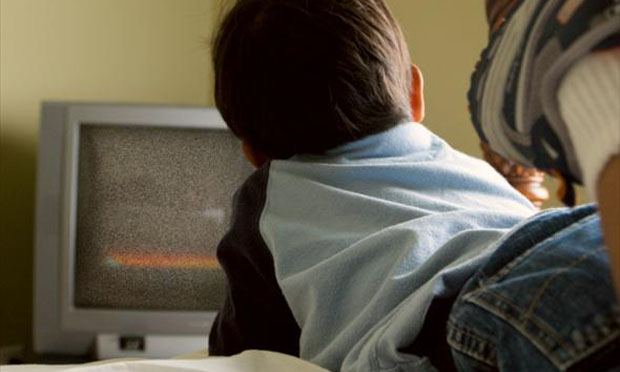
Like fatty foods and sugary drinks, television is something that’s highly popular despite being best in moderation. The potential negative effects of higher levels of TV viewing include lifetime weight gain, increased risk of heart attacks and higher rates of diabetes. More TV viewing has even been associated with less-informed voters judging political candidates by their appearance.
Numerous studies have shown that higher levels of television viewing can have a negative impact on children’s development, including a wide range of physical, behavioral and academic problems. The American Academy of Pediatrics recommends that children over age two years spend no more than two hours per day with screen media. But how much television are children exposed to when it’s simply left on in the background, as many families do?
A 2012 study published in the journal Pediatrics, “Background Television in the Homes of U.S. Children,” examined the amount of background television that infants and young children are exposed to, as well as related demographic factors. The researchers, at the University of North Carolina, University of Amsterdam and University of Iowa, surveyed nearly 1,500 parents or caregivers with one child between 8 months and 8 years of age. Daily television exposure was logged as well as factors such as the presence of a TV in the child’s bedroom.
The study’s findings include:
- The average child in the United States is exposed to 232 minutes (3.9 hours) of background television on a typical day. Because the average U.S. child watches an average of approximately 80 minutes (1.3 hours) of television on a typical day, background exposure dwarfs actual television viewing by a ratio of three to one.
- The younger the child, the more they were exposed to background television. Infants two years and younger were exposed to an average of 332 minutes (5.5 hours) of background TV per day. Children 6 to 8 years old were exposed to less than half that amount, 163 minutes (2.7 hours).
- Children in single-parent homes were exposed to significantly more background television that those living in multi-parent homes: 305 minutes (5.1 hours) versus 217 minutes (3.6 hours).
- Family income and background exposure are inversely proportional: Children in higher-income families were exposed to less background television while those in poorer families were exposed to more. “Children from the poorest families were exposed to nearly 6 hours of background TV on a typical day versus 3.5 hours for children whose income-to-needs ratio was above the poverty threshold.”
- The more educated the parents, the lower their childrens’ background TV exposure. “Children of caregivers with the greatest amount of formal education were exposed to [less than] 2.5 hours of background TV, whereas children of parents with high school diplomas or less were exposed to [more than] 5 hours on a typical day.”
- “African American children were exposed to marginally more background TV than white children (5.5 hours versus 3.5 hours).”
- Leaving the television on while no one is viewing and children’s bedroom television ownership were associated with increased background television exposure.
“This level of exposure easily dwarfs foreground television exposure,” the researchers state. “Considering the rates of background television exposure that we found along with the negative associations that other researchers have found between background television and cognitive and social outcomes, any effort to decrease background exposure seems worthwhile.” These include turning off the television when it’s not being actively watched, removing televisions from children’s bedrooms and having parents reduce their own viewing time.
A related study, “Associations of Television Content Type and Obesity in Children,” examined the effect of different types of television on obesity rates. After controlling for possible contributing factors, the researchers concluded that “television advertising, rather than viewing per se, is associated with obesity.”
Tags: children, youth, television, entertainment, parenting
